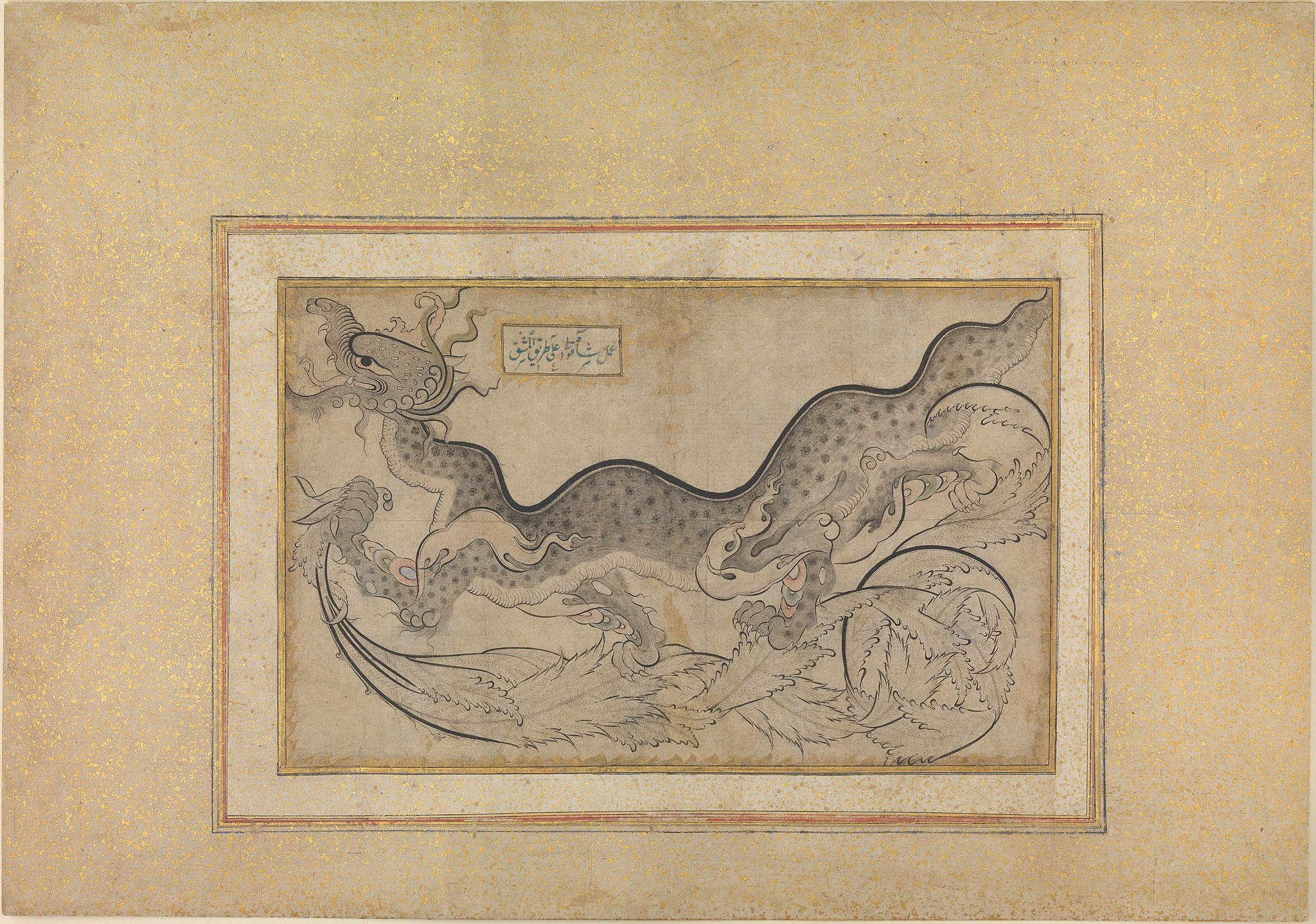
Dragon-Gallery


Matsuri Yatai Dragon by Katsushika Hokusai, 1844.

A Babylonian Cylinder Seal Depicting a Dragon-like Creature.

The Azure Dragon of the East, or Qinglong in Chinese, Represents the Spring Season.
RootOfAllLight, CC BY-SA 4.0 <https://creativecommons.org/licenses/by-sa/4.0>, via Wikimedia Commons

Azure Dragon Mural from the Goguryeo Tomb.

Flag of the Chinese Empire under the Qing dynasty (1889-1912)
Original: 清朝政府 Vector: Sodacan, Public domain, via Wikimedia Commons

Friedrich Johann Justin Bertuch, the mythical creature dragon, 1806
Friedrich-Johann-Justin-Bertuch, Public domain, via Wikimedia Commons

'Saz'-Style Drawing of a Dragon Amid Foliage
Artist: Shah Quli (Turkish, born Tabriz, Iran, active ca. mid-16th century) Date: ca. 1540–50. Şahkulu, CC0, via Wikimedia Commons

Dragon on Longshan Temple
WikiLaurent, CC BY-SA 3.0 <https://creativecommons.org/licenses/by-sa/3.0>, via Wikimedia Commons

Dragon from the Harley Bestiary. 13th Century.

Draco and Ursa Minor From Urania's Mirror, a Set of Celestial Cards Accompanied by A Familiar Treatise on Astronomy. 1825.


The Constellation Al-Tinneen or Draco, the Dragon.
Kitab suwar al-kawakib al-thabita (Book of the Images of the Fixed Stars) of al-Sufi. 18th Century. Abd al-Rahman al-Sufi, CC0, via Wikimedia Commons

Serpents of India, by Sebastian Muenster, 1552.
When the ancient Roman historian Pliny recorded seeing crocodiles fighting elephants, he described them as dragons. Münster repeats this dragon legend in Book V of his Cosmographia, devoted to Asia and specifically to India. Sebastian Münster, Public domain, via Wikimedia Commons

Dragon of Tai-Ahom People.
KhiLanTzi, CC BY-SA 4.0 <https://creativecommons.org/licenses/by-sa/4.0>, via Wikimedia Commons

Ancient Egyptian art depicting Apep being warded off by a deity. Tomb of pharaoh Ramses I. Thebes West, near 1307 BC.

Jörmungandr (the Midgard Serpent) from the 17th century Icelandic manuscript, now in the care of the Árni Magnússon Institute in Iceland.

Jörmungandr in the sea during Ragnarök, drawn by the Norwegian illustrator Louis Moe in 1898.
Louis Moe, CC BY-SA 4.0 <https://creativecommons.org/licenses/by-sa/4.0>, via Wikimedia Commons

Ouroboros drawing from a late medieval Byzantine Greek alchemical manuscript.
anonymous medieval illuminator; uploader Carlos adanero, Public domain, via Wikimedia Commons

First known representation of the ouroboros on one of the shrines enclosing the sarcophagus of Tutankhamun.
Djehouty, CC BY-SA 4.0 <https://creativecommons.org/licenses/by-sa/4.0>, via Wikimedia Commons

The ouroboros, August Kekulé's inspiration for the structure of benzene
Kekulé claimed that the structure of benzene appeared to him in a dream that included a snake eating its tail. DMGualtieri, CC BY-SA 3.0 <https://creativecommons.org/licenses/by-sa/3.0>, via Wikimedia Commons

A stylized ouroboros from The Book of Kells. 800 AD.
JaneMaxwell63, CC BY-SA 4.0 <https://creativecommons.org/licenses/by-sa/4.0>, via Wikimedia Commons

Engraving of an wyvern-type ouroboros by Lucas Jennis, in the 1625 alchemical tract De Lapide Philosophico.
The figure serves as a symbol for mercury. Public Domain, See Page for Author.

Japanese woodcut featuring an ourouboros-like dragon and depicting earthquake and tidal wave damage. 1855.

An illustration of the Ancient Norse Cosmos, showing the World Serpent, Jörmungandr

The tableau of Manipur passes through the Raj path during the 61st Republic Day Parade-2010, in New Delhi on January 26, 2010.

The triple Paduraksa gate and Naga stairs at Pura Parahyangan Agung Jagatkarta, West Java, Indonesia

Damballah La Flambeau or Damballah the Torch, by Hector Hyppolite.
Vishnu Kurmavatara and the churning of the milk ocean, A sculpture at Suvarnabhumi airport, Bangkok, Thailand

A Hundred Fables of La Fontaine - The Dragon with many Heads.
Author Jean de La FontaineIllustrator Percy James Billinghurst, Public domain, via Wikimedia Commons

The Tannin (Dragon), by al-Qazwini (1203–1283).

Taniwha, a Supernatural being in Māori legend that lives in deep pools, rivers, or dark places.
Illustration for a Maori language Childrens book, Te Taniwha Me Te Poraka, by Murray Grimsdale. Murray Grimsdale, CC BY-SA 2.0 <https://creativecommons.org/licenses/by-sa/2.0>, via Wikimedia Commons

Maya Man Posing with a Feathered Serpent carving, El Osario, Chichen Itza. 1923.

Double Headed Serpent from the Aztec Culture of Mexico.
This sculpture may represent the feathered Aztec serpent god Quetzalcoatl. British Museum, CC BY 2.0 <https://creativecommons.org/licenses/by/2.0>, via Wikimedia Commons

Detail of the Nine Dragons Handscroll by Chen Rong, 1244 AD, during the Southern Song Dynasty
The complete nine dragons handscroll can be viewed here. Chen Rong, Public domain, via Wikimedia Commons

Mušḫuššu, a creature from Mesopotamian Mythology.
Bas-relief in the Pergamon Museum. Allie_Caulfield from Germany, CC BY 2.0 <https://creativecommons.org/licenses/by/2.0>, via Wikimedia Commons

The Babylonian king Marduk-zākir-šumi, and his servant-dragon mušḫuššu, the "fierce snake". (9th cent. BCE).
Franz Heinrich Weißbach, Public domain, via Wikimedia Commons

: Top fragment of a kudurru with a mushhushshu dragon and divine symbols
Mesopotamia, 1156–1025 BCE. Metropolitan Museum of Art, CC0, via Wikimedia Commons

A Kwakwaka'wakw Sisiutl dance mask, made by Oscar Matilpi. Made of cedar wood.
The sisiutl is a legendary creature found in many cultures of the Indigenous peoples of the Pacific Northwest Coast. Usually it is depicted as a double-headed sea serpent. Kabuto 7 at English Wikipedia, Public domain, via Wikimedia Commons

Korean Imugi or "Lesser Dragon" Giant Serpent Ornament, Goryeo dynasty
국립중앙박물관, KOGL Type 1 <http://www.kogl.or.kr/open/info/license_info/by.do>, via Wikimedia Commons

Bahram Gur's Combat with the Dragon.
Shah-nama. Shiraz. Topkapı, Folio 206, verso of Hazine 1511 Topkapı Palace Museum Library, CC BY-SA 4.0 <https://creativecommons.org/licenses/by-sa/4.0>, via Wikimedia Commons

Elephant parent and child, with their arch-enemy dragon.
From a mideval French bestiary. Anonymous Unknown author, Public domain, via Wikimedia Commons

The Swiss Stollworm, or "Dragon of the Mine Tunnels" in the Bernese Alps. Karl Wilhelm von Dalla Torre (14 July 1850 – 6 April 1928), CC BY-SA 4.0 <https://creativecommons.org/licenses/by-sa/4.0>, via Wikimedia Commons
